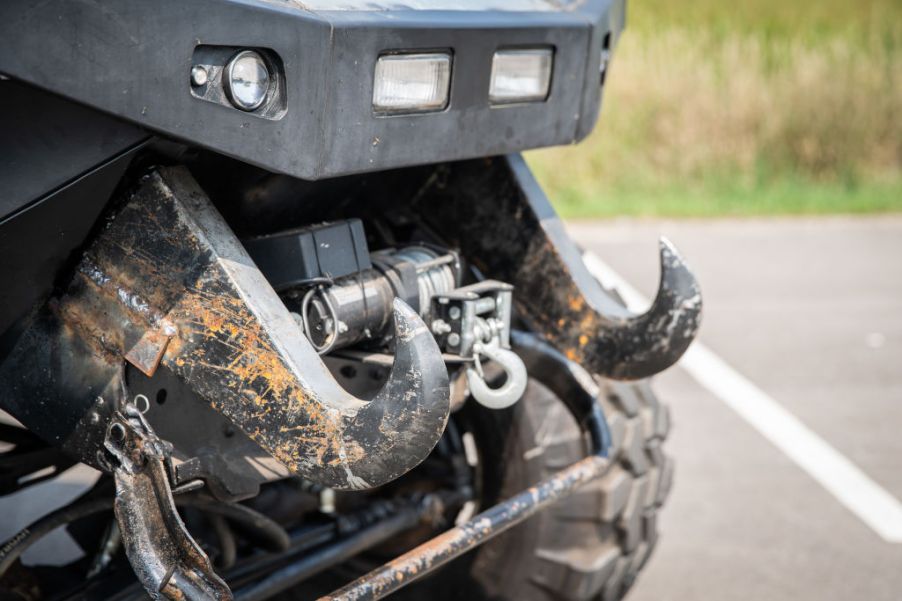
How Does a Truck Winch Work?
Let’s face it. When you go off-roading, chances are high that your truck will get stuck. It doesn’t matter whether your terrain of choice is sand, mud, rocks, or snow. And if it doesn’t happen to you, it could be someone else on the trail who needs help getting unstuck.
For those reasons and others, a truck winch is one piece of equipment you shouldn’t leave home without. With some help from Autowise.com, let’s discuss why you need one, how to use it properly, and what a truck winch typically costs.
Reasons why you need a truck winch
The more technical the terrain, the more likely even a good tow strap won’t be up to the task of pulling you or someone else out. But a strong winch motor will. It can do the job gradually instead of yanking it and possibly damaging your vehicle or other property like a tow strap might.
A winch can also help right a truck following a rollover. Recovery with a tow strap in a situation like this is difficult and becomes nearly impossible if the vehicle must be dragged uphill. A winch, however, has enough controlled power to pull a vehicle back onto its wheels.
Another similar use for a winch is when you need to move an inoperable vehicle off a trailer. Some truck owners use winches to clear their properties of big rocks or logs, too.
How a winch works
The kind of winch you see on the front of Jeeps or other offroaders is a powerful and versatile tool. It can be electrically or hydraulically powered, but some older manually-cranked winches still exist. Electric winches are convenient because they can run off your truck’s battery. If you need heavy-duty towing, however, a hydraulic winch is better suited for the job.
A mechanically-operated winch is a device that pulls in or lets out cable or rope in order to adjust tension on it. The cable, which can measure between 40 and 150 feet, is wound around a drum. A motor turns the drum to feed out or pull in the cable, and a gear train controls the motor’s speed so it gets enough torque to adjust the cable’s tension.
Accessories that make winching safer and easier include a pair of heavy gloves, a tree saver strap, snatch blocks, and shackles. You will also need to make sure you have a winch-ready bumper on your truck.
How to use a truck winch properly
Here are the basic steps for using a winch properly:
- Plug in the winch’s remote control and disengage the clutch that releases the cable.
- Find something large and stable, like a tree, in front of your truck to anchor your winch. If you can, try to find an anchor that isn’t too far off to the left or right of your vehicle.
- Pull enough cable to winch the vehicle.
- Put a tree saver strap around your anchor and attach the cable to it using a shackle. Attach the shackle to the winch hook with the tip facing up.
- Use the remote control to pull the winch cable taut.
- Before pulling the vehicle out, make sure that anyone nearby is standing clear of the winch cable and vehicle.
- Get in your truck, put it in neutral, and slowly winch the vehicle using the remote control. As the vehicle moves forward, you can put the vehicle back into gear and lightly press the gas pedal to advance it.
- Stop winching once your vehicle is unstuck.
- Unrig the winch by unhooking the winch hook from the shackle.
- Rewind the cable slowly with the remote control and unplug the remote when the cable is rewound.
- Remove the tree saver strap and the shackle from your anchor.
Winch safety and cost
It almost sounds too easy, doesn’t it? But when you’re winching a vehicle that weighs thousands of pounds, you have several possible points of failure. The cable could snap or something could break loose and become a projectile.
Avoid injury by being aware of the safety hazards and knowing how to keep things from going wrong. Here are some tips to keep you and bystanders safe:
- Use gloves when handling the cable. Also, paying out the cable hand over hand is a safer way to control it as you rig the winch.
- Check your winch and accessories before using them. Know the working load limits on your winch cable, tree saver strap, and shackle to make sure they can support the vehicle’s weight.
- Make sure there are no obstacles between your vehicle and the anchor that the winch cable could get caught on.
- Keep your remote control clear of the winch’s drum.
- Stay clear of the cable while it’s tensioned.
- Slow and steady is safer when using the winch remote control to pull out your vehicle.
A winch becomes an essential piece of equipment when you spend a lot of time offroading. Depending on how much weight you plan to winch and whether you want synthetic rope or steel cable, winch prices range from just under $300 to over $1,000. Generally, hydraulic winches are more expensive than electric ones.
Whichever winch you choose, you can hit muddy tracks or snowy trails with more confidence knowing you have the right tool to recover your vehicle.


